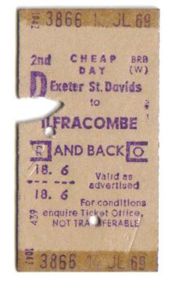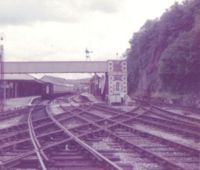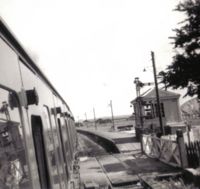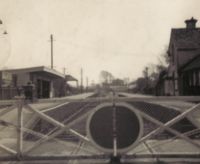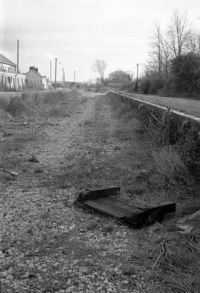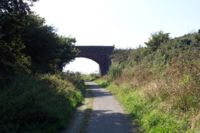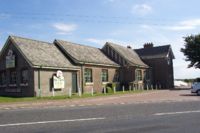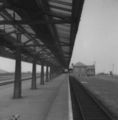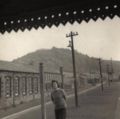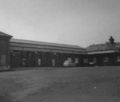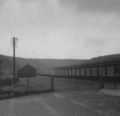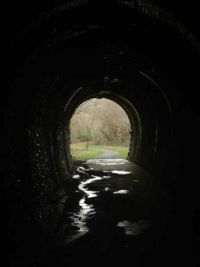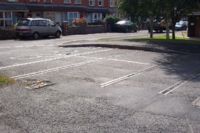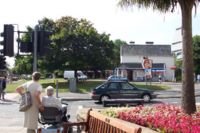Ilfracombe Branch Line
| The Ilfracombe Branch | ||||||||||||||
Stations:
|
The Ilfracombe Branch of the London & South Western Railway (LSWR), ran between Barnstaple and Ilfracombe in North Devon. The branch opened as a single-track line in 1874, but was sufficiently popular that it needed to be upgraded to double-track in 1889.
The 1-in-36 gradient between Ilfracombe and Mortehoe stations was one of the steepest sections of double track railway line in the country, and was most certainly the fiercest climb from any terminus station in the UK. In the days of steam traction, it was often necessary to double-head departing passenger trains.
'Named' trains like the Atlantic Coast Express and the Devon Belle both started and terminated at Ilfracombe.
Despite nearly a century of bringing much-needed revenue into this remote corner of the county, the line succumbed to the onward march of the private car, passenger traffic dwindled and the line closed in 1970.
Much of the course of the line is still visible today, and sections of it have been converted into public cycleways.
History
On 20 July 1874 a railway link was opened between Barnstaple and Ilfracombe. The line was originally laid as a single-track light railway, which restricted the type of trains that could use it.
Popularity led to expansion, and much of the line was converted to double track between 1889 and 1891. This was a major exercise, requiring the rebuilding of most stations, and cutting a second bore for the Slade tunnel.
The line was mentioned in the Reshaping of British Railways report or the Beeching Axe review, in 1963. As a line for closure. But the line was not closed by British Railways until 1970. Indeed, steam-hauled passenger services and freight operations ceased on 7 September 1964 (with one special running on 3 October 1965), and the rationalisation of the line began. DMU services began, the Waterloo through services were stopped, and the line was down-graded to single track on 25 November 1967.
It was in May 1967, that the Network for Development Plans were issued by Barbara Castle, the then Labour Minister of Transport following a study. Where lines were at the remunerative end of the scale, such as the main trunk routes and some secondary lines, these would be developed. But those that failed to meet the financial criterion, but served a social need were to be retained and subsidised under the 1968 Transport Act. The problem would be for lines that were not in the abovementioned categories could be candidates for closure as they did not form part of the basic railway network. The Illfracombe line was one of those that fell into this category. It was a line that may well have carried considerable traffic, and perhaps made a small profit, but it did not meet the Government's social, economic and commercial criteria for retention.
The line was closed on 5 October 1970 the last train being on 3 October. The final train, an 8-car Class 118 DMU, was packed to bursting point.
There was an abortive attempt, in the early 1970s at saving the line, but as the preservation movement was in its infancy and the project was to founder as it could not raise the required sum to purchase the line outright. This was because BR had valued the line at £410,000 in 1974, and certainly BR was criticised for charging market values for a potential heritage railway that wanted to preserve it. It must be appreciated that the BR board was under instruction from the Ministry to fix the highest price possible in an attempt to recoup funds to offset the deficit that the line produced.
The last train was formed of a single inspection saloon hauled by a Class 25, 25 063, on Wednesday 26 February 1975. This carried engineers inspecting the condition of the track for possible reinstatement of services. However this was not to be and track lifting commenced in June 1975. The following link has a number of rare pictures of the last train on the line. [1]
The distinctive curved steel girder bridge over the River Taw in Barnstaple was demolished in 1977, effectively terminating any hope of the line seeing through traffic again.
Stations
Barnstaple Junction
- Main article: Barnstaple Junction Station
- Simply named Barnstaple before the building of the Ilfracombe branch.
Connections to:
- LSWR Route to Exeter (still active as The Tarka Line)
- GWR Barnstaple to Taunton railway
- LSWR route to Bideford, Great Torrington and beyond
Barnstaple Quay
- Main article: Barnstaple Quay Station
- The original station to the north of the bridge
- Renamed Barnstaple Town in 1886
- Closed in the same year, when the larger new Barnstaple Town opened, to cope with the Lynton and Barnstaple Railway.
Barnstaple Town
- Main article: Barnstaple Town Station
- 250yards west of the site of Barnstaple Quay
- Moved to the wider site to allow provision of a second platform
- Connection for the Lynton & Barnstaple Railway
- See station article for more pictures
Wrafton
- The smallest station on the line
- Served the village of Wrafton and the aerodrome of RAF Chivenor
- Single platform and two goods sidings, one for the RAF base
- In later years housed a couple of camping coaches in goods yard
- Station building is now a private house
Braunton
- Served the village of Braunton
- Station building now used as a newsagents
- Goods shed was converted for use as a local youth club
- The second picture was taken from almost the same viewpoint
Mortehoe & Woolacombe
- Main article: Mortehoe & Woolacombe station
Over a mile from either Woolacombe or Mortehoe, the villages were reached by steep twisty roads from the station.
The bridge at the north end of the station was the summit of the line.
Several sidings were provided for the stabling of banking locomotives, vital for assisting trains up the steep gradients to the station from Ilfracombe (1-in-36) or Braunton (1-in-40).
The station is still largely intact. The main station building, signal box and platforms are still extant, and some of the original concrete lampposts are still in place. The 'canopy' opposite the station building, however, was added long after the line had closed.
'Once Upon a Time'
Until recently the station was the site of a young children's theme park called Once Upon a Time, which was operated by the owners of Watermouth Castle.
The station site is in a prominent position on the main road leading to Woolacombe. From outside the site can be seen four (BR Mk 1) carriages (retired from the Dart Valley Railway) sited between the platforms, while scattered around the grounds are a number of '12 ton' van bodies used for storage or housing attractions. (Several of these are of the BR type 'VANWIDE', their double sliding doors being particularly useful for the purpose.)
The business closed at the end of the 2005 season. The site was sold in 2006, and is earmarked for re-development as affordable rural housing.
Ilfracombe
- Main article: Ilfracombe railway station
- The terminus.
- Included an engine shed, turntable, goods yard and many sidings to cope with stabling the lengthy passenger trains used on summer Saturdays.
- The site is now the location of the Pall Europe factory.
Gallery
Ilfracombe station on 14 July 1969
Mortehoe Bank
The most notable feature of the line were the steep climbs - from both directions - to the summit at Mortehoe station.
Other lines had steep banks too. The famous Lickey Incline, between Bromsgrove and Blackwell on the Gloucester to Birmingham line, is now the steepest sustained adhesion-worked gradient on British railways, with a northbound climb of 1 in 37¾ for two miles. In steam days, all except the lightest trains required the services of a banker; however, since dieselisation, this is no longer necessary, except for certain freight services.
Rather nearer are the Dainton Banks - a 4-mile stretch of the GWR main line between Newton Abbot and Totnes. This section was designed for atmospheric propulsion, rather than steam haulage, and consequently has curves and gradients that would not be dreamed of for a loco-hauled line. The westbound ascent to Dainton Tunnel includes gradients between 1 in 57 and 1 in 36 over a two-mile stretch. Eastbound is slightly easier, comprising, in the space of one mile, gradients of 1 in 55 to 1 in 37.
Nevertheless, The Mortehoe banks were much harsher. Northbound there was a 3½ mile continuous climb of 1 in 41, from Heedon Hill Crossing to Mortehoe. While southbound, from Ilfracombe to Mortehoe, the climb was 1 in 36 for 2½ miles, with severe S-curves past Lower Slade making the journey even harder. It was the climb out of Ilfracombe that was the 'killer', being the steepest gradient leaving a terminus station in the British Isles.
Banking engines were kept at Braunton and Ilfracombe, to assist when required. Mortehoe station provided a number of sidings for stabling the banking engines after assisting with the climb.
Locomotives
The severe gradients and sharp curves of the line have always limited choice to the smallest engines in the fleet.
The original motive power was provided by a class of small 0-6-0 tender locos that later became known as the Ilfracombe Goods (see below).
LSWR "Jubilee" Class A12 0-4-2s replaced the Ilfracombe Goods engines on passenger work, and were themselves replaced by the T1 Class 0-4-4Ts around the turn of the century. From about 1914, LSWR Class M7 0-4-4Ts were commonly used.
After the Grouping, the Southern Railway introduced the new Maunsell N class 2-6-0s, in 1925. These were used for services to Exeter and beyond until the arrival of the 'light pacifics' in 1945.
The Bulleid West Country and Battle of Britain classes of 'Light Pacific' were the largest engines to visit Ilfracombe, and were the preferred choice for the Waterloo services and the Devon Belle. In later years, despite the removal of their 'air-smoothed' boiler casings, the rebuilt examples of these engines would not have been seen, as they were too heavy to use the line.
As may be inferred from the name, the West Country locos were named after places in south-west England to which the Southern Railway ran. Enthusiasts always delighted in trying to take pictures of these engines at their 'home town'; and they had many opportunities on the Ilfracombe branch, since there were locos named: Woolacombe, Mortehoe, Barnstaple, Ilfracombe and Braunton.
Following Nationalisation, many more through trains were timetabled from Taunton, leading to an increase in the number of ex-GWR locos that visited the branch. Ideally suited to the work were the 43xx class 'Moguls' (2-6-0 tender locos) and the 2251 class 'Colletts' (0-6-0 tender locos).
In September 1964, all steam haulage was withdrawn from the line, and most services were thereafter provided by diesel multiple units. However, some long-distance trains still operated, and these were usually loco-hauled.
In later years many different diesel-hydraulic classes appeared on the line, including Baby Warships, Hymeks, and Warships.
A pair of Class 33 (Cromptons) were also noted on the line, including 33 048 (now preserved on the West Somerset Railway), on 30 August 1970 with the West Sussex Railway Touring Trust 'Chartex Special'.
The last train was also hauled by a Class 25: 25 063.
The "Ilfracombe Goods" Locos
...built by Beyer Peacock - see 'External links'.
Services
The 'N'-class locomotives were limited to fifteen loaded wagons over the Mortehoe bank, however if there were more than eleven trucks, the train was required to have two manned brake vans.
A year after the end of regular steam operations, the Southern Counties Touring Society ran the "Exeter Flyer", a special train on the 3rd October 1965 (hauled by BR Standard Class 4MT 2-6-4T no 80043).
The introduction of a full DMU service in September 1964 resulted in through workings from Exmouth, Sidmouth, Honiton and Salisbury, but direct Waterloo services were discontinued.
Walking the Line Today
The trackbed between Mortehoe Station and Ilfracombe has been restored as a cyleway and forms part of the Tarka Trail. It is possible to walk or cycle from the north road bridge parapet by Woolacombe & Mortehoe Station, down the long descent towards Ilfracombe, passing the Slade reservoirs and going through the twin-bore tunnels cut just to the south of Ilfracombe station.
The former line is surrounded by the Cairn - heathland planted with trees during the 1960s and transformed into a Local Nature Reserve.
South of Woolacombe, it is easy to follow the course of the line by car, as the trackbed closely follows the A361 road for much of the route between Barnstaple and Mullacott Cross (just outside Woolacombe/Ilfracombe).
Ilfracombe Museum contains many photographs and relics from the line, including a gradient post and one of the concrete station name boards from Ilfracombe Station (both visible outside the building).
References
- A regional history of the Railways of Great Britain - Volume 1 The West Country - David & Charles (1960)
- Back along the lines - North Devon's Railways by Victor Thompson - Badger Books (1983) ISBN 0-946290-03-2
- The Barnstaple & Ilfracombe Railway by Colin Maggs - Oakwood Press (19xx) ISBN 0-85361-368-0
- Branch Line to Ilfracombe by Vic Mitchell & Keith Smith - Middleton Press (1993) ISBN 1-873793-21-9
- The Ilfracombe line by John Nicholas - Irwell Press (1998) ISBN 1-871608-77-5
See also
- other local railway attractions:
